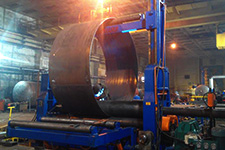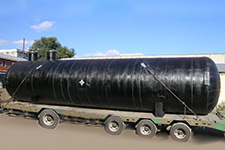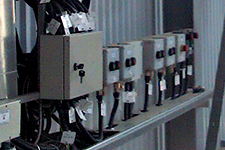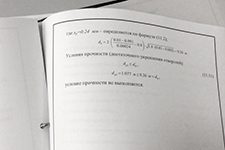THE RANGE OF SERVICES
Design, installation, construction, starting-up and commissioning of the equipment for aerosol production
THE RANGE OF SERVICES
Design, installation, construction, starting-up and commissioning of the equipment for aerosol production
OBJECTIVE
Storage, filling cylinders and cans with dimethyl ether and aerosol
CERTIFICATION
SP 62.13330.2011
ТР ТС 032/2013
ISO 9001:2015
Aerosol production plants are widely applied at the enterprises of chemical, construction engineering and paint-and-varnish industries and serve for gas and propellant supply to aerosol cans.
The aerosol production line allows to provide technological processes with a two-phase aerosol which consists of gas vapors and propellants - substances capable to convert the operating environment into foam, spray or powder under pressure. The most common propellants are a group of liquefied petroleum gases (LPG), such as propane, butane and propane-butane mixture, as well as dimethyl ether (DME).
The weight content of propellant is determined depending on the type of aerosol and affects the structure of the sprayed product: fine substances, poly-disperse mixtures, etc.
| Application | Aerosol type | The weight content of propellant |
|---|---|---|
| Household cleaning products | Antistatics, air freshener, planishing (buffing, polishing substances), etc. | 60-80% |
| Bacteriological decontamination, exterminating and disinsectant substances, etc. | 70-90% | |
| Paint-and-varnish industry | Paints, varnishes and lacquers, enamels | 20-60% |
| Industrial application | Aerosol mastics, corrosion preventatives | 20-50% |
| Construction foam | 20-30% |
The core functionality of aerosol product line is as follow:
The competent implementation of the aerosol production line project allows for the uninterrupted supply under pressure of a limited amount of liquefied gas and propellant of required quantity. In case of allowable gas concentration excess or an emergency, the supply of LPG and DME can be stopped manually, remotely automatically by means of electromagnetic valves with the possibility of pipelines opening and closing. Valve response time depends on the pipeline diameter and is at least 30 MS.
Aerosol production line includes a technical liquids and propellants storage warehouse, aerosol cylinders filling equipment, control room or desk and a quality control equipment. The typical layout is as follow:
Storage tanks can be installed both above and uderground. The choice of the location mode is determined by free space at site, the allowable distance between the tanks, climatic service conditions, etc.
The number of LPG and DME tanks depends on daily and annual output rate, as well as the requirements to a number of stand-by tanks. Tank manufacturing is carried out by the Plant SARZ Ⓡ in accordance with Quality management system ISO 9001-2015 and the requirements of Russian state and industry standards.
The exact equipment configuration and its characteristics are selected taking into account the optimal compliance with the technical design specification and Customer's requirements. All the supplied equipment is delivered fully shop-assembled. It reduces construction and installation period and gears up commissioning.
The gasholder is designed for underground or above ground dimethyl ether or liquefied petroleum gas storage and is filled up to 85%. Dimethyl ether acts as a solvent, liquefied gas is used as a foaming agent.
The processing medium flows from gas pipeline to the pumping unit. The type of pumping unit (with metering equipment, self-priming, side-channel) depends on either above- or underground tanks as well as required output rate. Due to the pump circular fluid motion is achieved under pressure of about 10-12 kg/cm2. Flow control is carried out by a solenoid valve which can also be used for cylinders filling.
Technological processes control is held up by control equipment, which transmit data to the control cabinet (pressure, temperature, filling level etc). The standard list of equipment includes electric-contact or visual pressure gage, thermometer, ultra-audible level alarm, magnetic displacer level transmitter, sensors, differential level sensor, etc.
The processing medium is discharged from the gasholders by means of a compressor unit, which removes the dimethyl ether and liquefied petroleum gas through the draining station into the tank truck at a speed of up to 220 l/min.
STAGES PERFORMED








Construction and installation works require site preparation. The work area should correspond to the general layout and have approach drive and clearing construction site for heavy construction vehicles moving.
The scope of dirt works may vary depending on the type of tanks (above- or underground).
| Work item | Aboveground tanks | Underground tanks |
|---|---|---|
| Site stripping | + | + |
| Ground survey | + | + |
| Clearing and grubbing | + | if applicable |
| Foundation installing | + | + |
| Ditch for foundation | - | + |
| Tank burial | - | + |
Regardless of the tank type the tank foundation is essential. The foundation is reinforced-concrete assembly or site concrete foot. The foundation diameter should be more than the tank diameter. Pole or saddle is placed upon the foundation so that the pressure-tight seam is externally inspectable. At the point of tank shell and tank rack contact waterproofing covering is coated, which provides biological impact and chemical attack resistance.
Aerosol production lines are manufactured by SINTEK and meet the requirements of Federal norms and regulations, as well as industry standards. While designing, construction, starting-up and adjustment the specialists of design engineering department are guided by:
Compliance with the requirements specified in the documents listed above ensures long-term service and decrease of emergences due to the equipment high quality.
Specialists of OOO Neftegazengineering carry out cost and time calculation depending on the required output rate, equipment configuration (the number of tanks, spill lines, storage capacity, gas pipe length), as well as the range of construction and installation works.